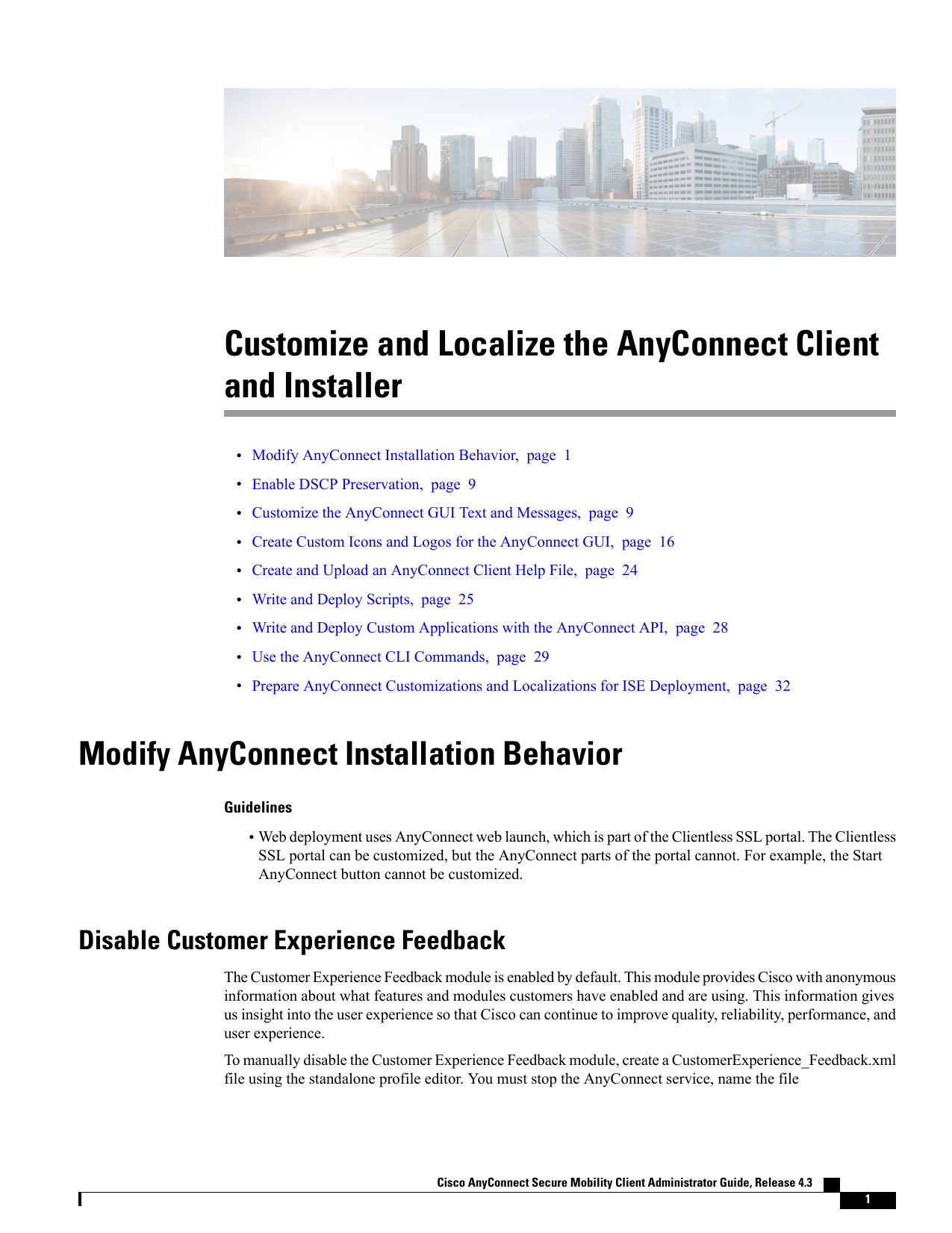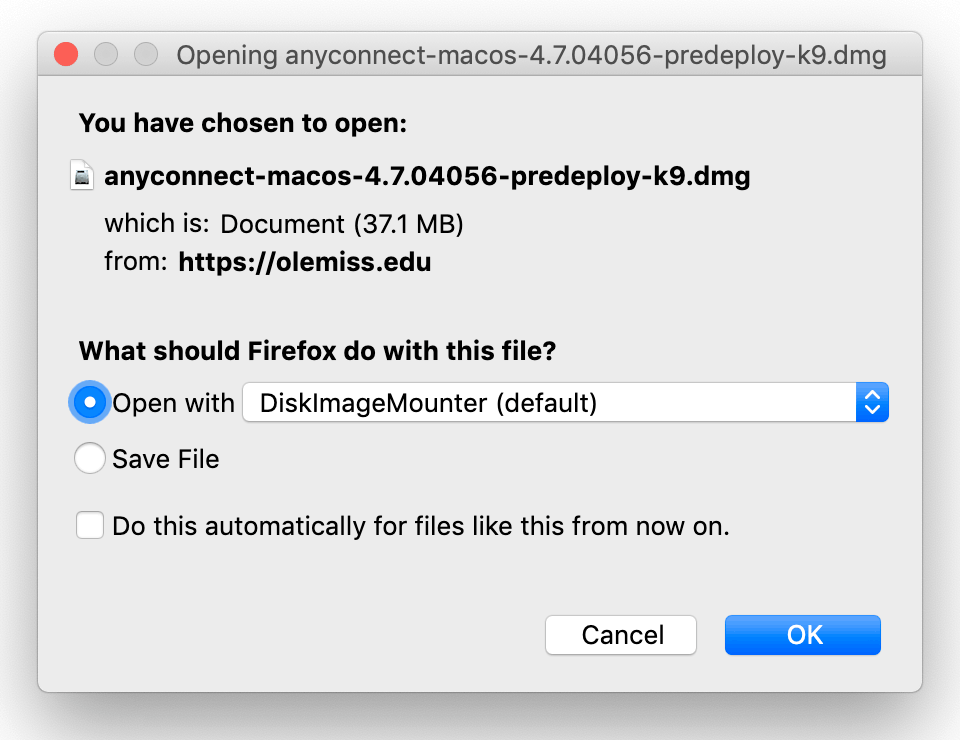Cisco AnyConnect Secure Mobility Client v4.x AnyConnect Secure Mobility Client Features, Licenses, and OSs, Release 4.10 08-Apr-2021 AnyConnect Secure Mobility.
ASA-5506X(config-webvpn)# anyconnect image disk0:/anyconnect-macosx-i386-4.2.02075-k9.pkg 3 ASA-5506X(config-webvpn)# anyconnect enable When dealing with multiple clients (supported platforms) of AnyConnect, assign an order to the client images using the numbers (1, 2, 3) at the end of each package command as shown above. Modify Installation Behavior,macOS TheAnyConnectinstallercannotbelocalized.ThestringsusedbytheinstallercomefromthemacOSinstaller application,nottheAnyConnectinstaller. Cisco AnyConnect is a client that is installed on your home personal computer or your University managed computer. After connecting with the AnyConnect client, you can access campus resources and use them as though you were on campus. How to install on a personal Windows computer How to install on a personal Macintosh computer. Installer ‑showChoicesXML ‑pkg /path/to/AnyConnect.pkg ‑target / That will print a bunch of information to standard out (the terminal window), so I will often redirect it to a file for saving and easier reading/searching like so: installer ‑showChoicesXML ‑pkg /path/to/AnyConnect.pkg ‑target / /Desktop/anyconnectchoices.xml.
Access to most active sessions in Cisco dCloud requires a VPN connection between your laptop and the dCloud data center that is hosting your active session.

Use one of the three options below to connect your laptop to an active dCloud session using Cisco AnyConnect VPN Client:
All options are described below in order of recommended use.
Due to differences in operating systems and AnyConnect versions, your screens may differ slightly from those included in the steps below.
Use Cisco AnyConnect Client Already Installed on Your Laptop
If you are logged in to Cisco AnyConnect, please log off before starting this procedure.
- In dCloud, go to My Dashboard > My Sessions, find the active session, and click View under the session.
- Open Session Details to view the AnyConnect Credentials for the session.
- Start Cisco AnyConnect on your laptop.
- Copy the Host URL from the AnyConnect Credentials and paste it in the URL Connection box in the AnyConnect login window.
- Click Connect.
Figure 1. dCloud AnyConnect Server Address Example
If you get a connection error, remove the “https://” part of the URL and try the connection again.
- Copy a user ID (Username) and the password from the AnyConnect Credentials and paste each into the Cisco AnyConnect login window.
- Click OK.
- Click Accept on the window confirming your connection.
- When connected to your AnyConnect VPN session, the AnyConnect VPN icon will be displayed in the system tray (Windows) or task bar (Mac).
- To view connection details or to disconnect, click the AnyConnect VPN icon and choose Disconnect.
Download and Install Cisco AnyConnect Client from Cisco.com
If you encounter any issues with this method, please download and install the software from dCloud.
- Go to the Cisco Support & Downloads page.
- You must be logged in with your Cisco.com credentials.
- You may be prompted to accept or comply with additional terms in order to download the software. Follow the directions on the popup window.
- Enter anyconnect in the Downloads box.
- Select a version to install from the search results.
- Cisco dCloud recommends AnyConnect Secure Mobility Client v3.x.
- Locate the package that you need based on your operating system.
- For Windows users, we recommend selecting Full installation package – Window / Standalone installer (ISO).
- For Mac users, we recommend selecting Full installation package – Mac OS X / Standalone installer (DMG).
- Click Download.
- You may be required to accept or comply with additional terms in order to download the software. Follow the directions in the popup windows that may display.
- Review the Cisco End User License Agreement and then click Accept LicenseAgreement on the End User License Agreement
- Install the software on your laptop.
- In dCloud, go to My Dashboard > My Sessions, find the active session, and click View under the session.
- Open Session Details to view the AnyConnect Credentials for your session.
- The AnyConnect Credentials in your active session are needed to download the software and to log in.
- Start Cisco AnyConnect on your laptop.
- Copy the HostURL from the AnyConnect Credentials and paste it in the URL Connection box in the AnyConnect login window.
- Click Connect.
Figure 2. dCloud AnyConnect Server Address Example
If you get a connection error, remove the “https://” part of the URL and try the connection again.
- Copy a user ID (Username) and the Password from the AnyConnect Credentials and paste each into the Cisco AnyConnect login window.
- Click OK.
Figure 3. Cisco AnyConnect Login Window Example
- Click Accept on the window confirming your connection.
- When connected to your AnyConnect VPN session, the AnyConnect VPN icon will be displayed in the system tray (Windows) or task bar (Mac).
- To view connection details or to disconnect, click the AnyConnect VPN icon and choose Disconnect.

Use the dCloud Browser Based Cisco AnyConnect
Install Cisco Anyconnect
Due to the Java applet used by this method, you may encounter compatibility issues with your local browser and/or installed version of Java. Use this option only if you cannot install the Cisco AnyConnect VPN Client on your laptop.
- In dCloud, go to My Dashboard > My Sessions, find the active session, and click View under the session.
- Open Session Details to view the AnyConnect Credentialsfor your session.
- The AnyConnect Credentials in your active session are needed to download the software and to log in.
- Click the Options link to open the Anyconnect Options popup.
- In the popup, find Use the dCloud Browser Based Cisco AnyConnect and then click the Host URL to go to the AnyConnect server address for the dCloud data center hosting your session. For example, the AnyConnect server address for the Americas data center is https://dcloud-rtp-anyconnect.cisco.com.
- Accept any security alerts or certificate warnings.
Figure 4. Host URL for dCloud Browser Based Cisco AnyConnect
- An SSL VPN Service window opens in a new tab in your web browser.
Figure 5. SSL VPN Service Window
- Copy a user ID (USERNAME) and the PASSWORD from the AnyConnect Credentials and paste each into the SSL VPN Service Login window
- Click Login.
If the automatic installation does not start, close and re-open your browser window.
- Follow the on-screen instructions to connect to AnyConnect.
- Accept any security alerts or certification warnings.
- When you have successfully connected to AnyConnect:
- A window will display, similar to below, advising of a successful connection.
- The AnyConnect VPN icon will be displayed in the system tray (Windows) or task bar (Mac).
Figure 6. Connection Established Example
If the automatic installation fails, install AnyConnect manually by following the on-screen instructions.
- To view connection details or to disconnect, click the AnyConnect VPN icon and choose Disconnect.
Related Information
UVM’s Virtual Private Network service allows remote users with UVM credentials to securely access resources that are normally only available to on-campus users.
Additionally, you must set up a Multi-Factor Authentication device to access the UVM’s VPN. See here for information and guides on available MFA methods.

Cisco Anyconnect 4.8 Download Windows
- Download the most recent version of the Cisco AnyConnect VPN client through software.uvm.edu.
- Please see this guide for help with the new Software Portal.
- Locate the file on your machine and double click it to launch the installer.
- After installation is complete, open the “Cisco AnyConnect Secure Mobility Client” from your Start menu.
- For login instructions, please see our guide for using the Cisco AnyConnect VPN client.
You will need an MFA method to access the VPN client.
- Download the most recent version of the Cisco AnyConnect VPN client through software.uvm.edu.
- Please see this guide for help with the new Software Portal.
- Locate the downloaded .pkg file on your machine and double click it. An installer wizard will launch, proceed through the installer.
- After installation is complete, open the “Cisco AnyConnect Secure Mobility Client” from your Applications folder.
- For login instructions, please see our guide for using the Cisco AnyConnect VPN client.
You will need an MFA method to access the VPN client.
Cisco Anyconnect Installer
- Install the Cisco AnyConnect app from the Google Play Store.
- Open the Cisco Any Connect app, then tap on the Connections menu.
- Tap on Add New VPN connection
- Enter the UVM connection settings as follows:
Description: UVM
Server Address: sslvpn2.uvm.edu
Once the settings have been entered, tap the Done button. - Ensure that your newly created UVM connection is selected, then tap the back button to return to the main menu of the Any Connect app.
- To connect, toggle the AnyConnect VPN switch to ON
- For login instructions, please see our guide for using the Cisco AnyConnect VPN client.
You will need an MFA method to access the VPN client.
- Install the Cisco AnyConnect app from the App Store.
- Open the Cisco AnyConnect app, then tap on the Connections menu.
- Tap on Add VPN Connection
- Enter the UVM connection settings as follows:
Description: UVM
Server Address: sslvpn2.uvm.edu
Once the settings have been entered, tap the Save button. - Press Allow at the prompt.
- Tap the UVM connection, then toggle the AnyConnect VPN switch to ON.
- For login instructions, please see our guide for using the Cisco AnyConnect VPN client.
You will need an MFA method to access the VPN client.
Related Articles
Cisco Anyconnect Vpn Software Download

